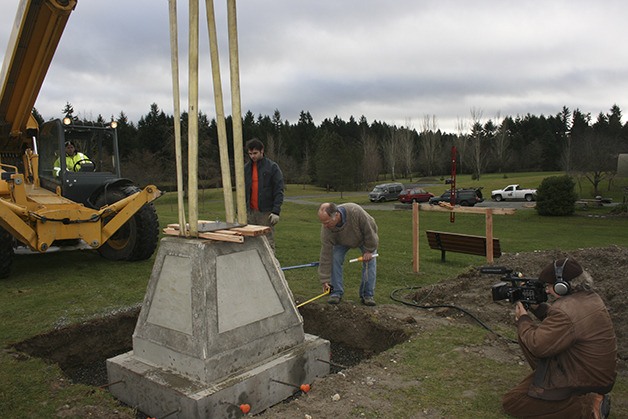Washington state may have more sundials than it does sunny days.
As of right now, there’s 50. One more is on the way.
Soon, Bainbridge Island will be added to the spots where a lost traveler may seek out one of the ancient time-telling masterpieces.
Even slower than watching the movement of the sun has been the fundraising process for the association in charge of bringing in the sundial.
For more than five years, the Battle Point Astronomical Association slowly raised $30,000 for the equatorial sundial. The new sundial will be placed in Battle Point Park sometime in the upcoming weeks, according to association members. It is made of steel and is coated with a bronze-colored paint.
“It’s going to be really impressive looking,” said Frank Petrie, sundial project manager. “It’s going to be visible from virtually everywhere in the park. I’m excited about it becoming a landmark, and I’m excited about the interest it’s going to generate.”
Even sundial expert Woody Sullivan, professor of astronomy at the University of Washington, is looking forward to the new sundial and is thrilled by the prospect, Petrie said.
“He’s excited to put our new sundial on his map,” Petrie said of the sundial enthusiast who has mapped Washington’s sundials over the years.
Designed by local artist Bill Baran-Mickle,the sundial is 9 feet across and sets on top of pedestal almost 12 feet off the dial. It will sit north of the Edwin E. Ritchie Observatory inside Battle Point Park once delivered from the fabricators.
Association members said there will be little upkeep, and if there is, it will fall on the group to take care of it.
“I suspect that it should last several hundred years,” said Steve Ruhl, president of Battle Point Astronomical Association. “The paint on it may need to be updated at some point, but that should last a long time, too.”
Ruhl said the sundial was painted at Lee Fabricators, Inc., a local company known for manufacturing Navy ship parts. PHC Construction donated labor and materials to construct the pedestal.
Added Ruhl, “It’s done correctly, so it should last a long, long time.”
Once the sundial is dropped off, the association members will install the gnomon, as well as calibrate and repair some concrete on the pedestal, Ruhl said.An informational plaque about the sundial will also be added.
“It will be pretty accurate,” Ruhl said of the sundial’s readings.
Ruhl hopes to have a public dedication on Summer Solstice and Father’s Day, which falls on June 21.
Ultimately, the Battle Point Astronomical Association hopes to educate and encourage an interest in science by installing the giant sundial as a focal point inside the park, members said.
Since most of the association’s events are held at night, the sundial is one way to engage the public in amateur astronomy activities, Ruhl said.
“Our observatory only works at night. We can’t look at the stars during the day, only the big one,” he said. “Putting something like that out that’s prominent, it has the opportunity to draw people in and get people inspired.”
While most astronomy activities do take place at night, there are opportunities to explore during the day, Petrie added, which is why the sundial starts a new conversation about what all astronomy encompasses. More plaques with information about the sundial and daytime astronomy will be added once the association finalizes the wording, he said.
“We’re hoping to inspire some young minds,” he said. “It’s going to be really, really cool.”



